Saving butterflies, moths and our environment
Celebrating our 40th Anniversary!
1982 - 2022
Never seen in Botley Woods?. After having read of a rare appearance of a Small Blue in a garden I thought I'd mention my only ever sighting in all the years I have been going there, of a Small Blue in Botley Wood. Having been excited by the return of Common Blues and Brown Argus to the site after years of seemingly nothing I noticed a small "intruder". Very quick and unable to distinguish as to whether it is a male or female, I did capture a photo! [Posted by Phil Lowe]
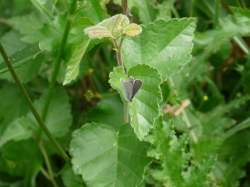 |
| Small Blue in Botley Wood Photo © Phil Lowe |
Grayling at Browndown. 67 Grayling at Browndown North but only 8 at Browndown South.
Somehow this report has been incorrectly posted under News for 02 July 2014. [Posted by David Tinling]
Painted Lady at Boarhunt. My first Painted Lady of the summer, seen today at Boarhunt, nectaring on water mint (Mentha aquatica) in the company of a Peacock and Comma. [Posted by Andrew Brookes]
Beautiful Downland. Visited Broughton Down and Stockbridge Down today - first visits for me. Stunning views at both sites but otherwise very different in character. The highlights were:
Broughton Down: Silver Spotted Skipper 6 (at last! - after 2 failed attempts at OWH)on the slope leading up to the round barrow. Dark Green Fritillary 2 (very faded), Brimstone 1, Chalkhill Blues, Common Blues and Brown Argus (just 1).
Stockbridge Down: Chalkhill Blues (in their hundreds - far more than at Broughton), Common Blues, Small Copper 4. A wonderful day! [Posted by Mark Wagstaff]
Noar Hill. A look around Noar Hill today I thought may have brought a Brown Hairstreak into view but today it wasn't to be. However I'm always surprised what the butterfly year can produce, and in one of the chalk-pits I saw a second Generation Duke of Burgundy, I've never seen one in July before, and I suspect there isn't many observers who have. It looked rather strange doing battle with Meadow Browns and being beat up by the many Common Blues around. I sat on an Ant Hill and just watched it looking rather out of place, and then it disappeared, whether it went into another chalk-pit looking for a female I don't know, but I visited the area at least three times over a three hour period, and it never re-appeared. There were good numbers of Silver-Washed Fritillaries still on the wing, Marbled White, and exceptional Common Blue numbers, with a lovely female being seen. Out of all the blues the female Common Blue is really is a beauty, when it has the blue marking on the brown colouration. [Posted by Ashley Whitlock]
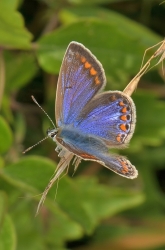 | 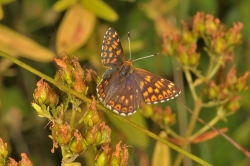 | 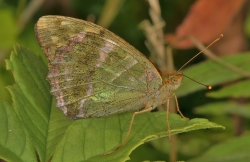 |
| Female Common Blue Photo © Ashley Whitlock | 2nd Generation Duke of Burgundy Photo © Ashley Whitlock | Female Silver-Washed Fritillary Photo © Ashley Whitlock |
Your Garden in August. Buddleia care. On 26th July I saw my first Painted Lady of the year on a friend's Buddleia and that was a timely reminder that our bushes need care at this time of year.
It is important to cut off the seed heads as they form so that the bush will flower again. Peter Moore of Longstock Park Nursery recommends doing this on a rainy day so that the dust does not cause sneezing!
In this hot weather Buddleias also welcome a drink - pour waste water around the roots to ensure that nectar flows freely and to stop the bush wilting and being stressed. Bushes also welcome an occasional liquid feed.
It is also a good time to propagate new bushes by taking cuttings. Keep in a cool shady place until they form roots.
Another tip is to grow buddleias in pots - that way their size is restricted and thus the task of pruning reduced. A second advantage is they can be kept close to the house when in flower but moved away when not. By pruning buddleias at different times in Spring flowers over a long period can be achieved. A new venture for me has been growing the dwarf buddleias from Thompson and Morgan called Buzz. Seems to be working well.
Collecting wild flower seed. A recent visit to the Butterfly Garden at Digne in Provence was a delight. There was a wonderful combination of cultivated garden plants and wild flowers - just the approach that really impressed me in Sue and Barry Clark's garden. Many of our wild flowers are attractive to butterflies and moths either for nectar or as caterpillar food plants.
No garden should be without Scabious, Knapweed, Cowslip, Bird's foot trefoil, Kidney Vetch, Marjoram, Wild Valerian, Viper's Bugloss or Dark Mullein. Seed of these is easily gathered ( with the land owner's permission) - now is the right time. Or seeding plants can often be spotted on road verges where like as not they will get cut down by the Council!
Sow the seed straight away in seed trays. Some will not germinate until next Spring. Once the seedlings can be handles easily pot on into 8cm pots (3" in old money) and plant in the garden when robust. And if you are thinking that many of these need chalky soil and yours is not, then either grow them in pots with chalk or incorporate old mortar in your soil so that the plants will thrive. The butterflies and moths will love them.
Lynn Fomison [Posted by Lynn Fomison]
Clouded Yellow Sighting. Travelling in company with my wife and father in the car in New Lane, Havant we saw a Clouded Yellow fly past as we stopped at the junction with Crossland Drive in New Lane (SU724072). Reporting this back at home in Cornwall after an enjoyable break in Hampshire and Wiltshire. [Posted by Richard Symonds]
Long Tailed Blue at Osborne IOW. Female Long Tailed Blue on edge of meadow Swiss Cottage Osborne House Isle of Wight [Posted by Mark Hallett]
Brown Hairstreak On Egg-laying Dry Run?. I visited Shipton Bellinger this afternoon and met up with several other Brown Hairstreak observers at the Hampshire County Boundary hedge. A male Brown Hairstreak was already resident and feeding on bramble, but just out of comfortable camera range. The highlight of the afternoon then followed, as a female Brown Hairstreak was spotted further down amongst the blackthorn. She spent much of her time crawling the blackthorn stems searching for suitable egg-laying sites, occasionally dipping the tip of her abdomen onto the stem. We could not confirm any eggs were actually laid, so suspect this was a dry-run in practice for the real thing. One of these ‘dipping’ movements was captured on camera.
Thankfully she did emerge frequently from the shadows for a spot of sun-bathing or just to take a closed wing break from her reconnaissance mission! We followed her all the way down the thick blackthorn hedge right to the end, from where she flew up into the trees. Needless to say, on our return the said male was still on his bramble perch taking nectar - by all accounts he had been occupying virtually the same spot for more than 2 hours! [Posted by Alan Thornbury]
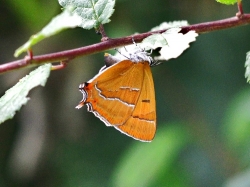 | 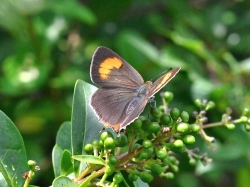 | 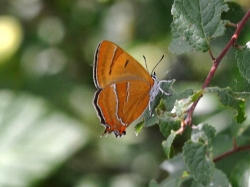 |
| Brown Hairstreak, Female, Egg-laying Behaviour Photo © Alan Thornbury | Brown Hairstreak, Female Photo © Alan Thornbury | Brown Hairstreak, Female Photo © Alan Thornbury |
Grayling at Bricksbury Hill. A more sedate walk was required today so I went three miles from home to check if Grayling were evident on the heath at Beacon Hill near Church Crookham. As I had expected they were and I counted 11 in a small area called Bricksbury Hill at SU829496. Along the rides female Common Blues were at regular intervals with the odd male just being a male.A Small Copper was busy on Ragwort along with many Meadow Browns and Gatekeepers.In the company of Chiff-chaff,Whitethroat and many Emperor Dragonflies I was able to come back to earth after yesterdays excitement. [Posted by Colin Baker]
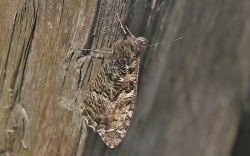 | 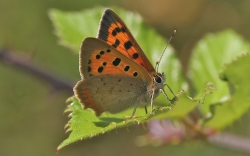 | 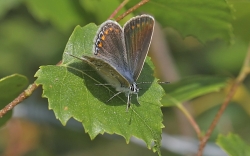 |
| Grayling Photo © Colin Baker | Small Copper Photo © Colin Baker | Common Blue-Female Photo © Colin Baker |
Old Winchester Hill. I seem to be the third recorder to report on OWH in as many days obviously we’re all looking for the same thing the Silver-Spotted Skipper. I can say after having spent three hours on three south facing slopes that it hasn’t emerged here yet, despite the fact the site I visited yesterday Oxenbourne Down is less than two miles away. I have noticed over the past decade that it is a later site for this specie and the Adonis Blue. But there were Dark Green Fritillary on the wing with the last of the Marbled Whites, many Small Skipper and Essex, Gatekeeper, Meadow Brown, and Brimstone. Thousands of Chalkhill Blue, and a sprinkling of Common Blue and a few Brown Argus. One Clouded Yellow was also seen. [Posted by Ashley Whitlock]
Old Winchester Hill. OWH alive with butterflies this morning.
Chalkhill blues in the hundreds, common blues 5, brown argus 6, clouded yellow 7, painted lady 1. Also pristine small tortoiseshells and peacocks. No sign of silver spitted skipper yet. [Posted by Mark Wagstaff]
Old Winchester Hill Photos. After editing these are a few of my photos from my visit to Old Winchester Hill on 29th July. The close up view of the head of the Essex Skipper clearly shows the black antennae. [Posted by Richard Symonds]
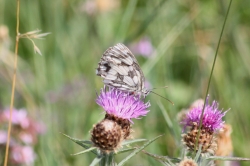 | 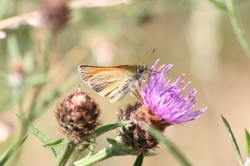 | 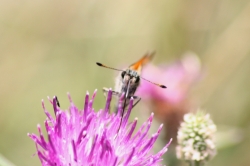 |
| Photo © Richard Symonds | Photo © Richard Symonds | Photo © Richard Symonds |
Clouded Yellow at Gosport. Clouded Yellow near the western end of the Haslar Sea Wall,Gosport. [Posted by David Tinling]
Clouded Yellows at Old Winchester Hill. Today I visited Old Winchester Hill in company with my father and my wife, a site I last visited 4 years ago when I lived in Hampshire. We walked from the main car park turning left, then around the outer paths of the fort, then down the steps. We then took the right hand path back along the way we walked to the fort (where I stopped recording), before resuming again following a path which ran close to the Clanfield to Warnford road. The temperature was 26 degrees which prevented us from attempting the steep slope which returns you back to the car park.
We saw total of 21 different species. Chalkhill Blues were flying in their hudreads if not thousands, while I counted 187 Small Skippers, some of which may have been Essex Skippers of which I positively identified 5. Despite very careful observations, I saw no Silver Spotted Skippers. On the South side of the hill fort 3 Clouded Yellows were seen. At one point two were chasing each other while another flew into the meadow just outside of the reserve. A single fresh Painted Lady was seen while 32 Small Tortoiseshell and 46 Marbled White were flying. Many Chalkhill Blue, Common Blue, Meadow Brown and Small Skipper were infested with the red mite parasite. Other species recorded were: Brimstone, Large White, Small White, Gatekeeper, Ringlet, Speckled Wood, Holly Blue, Brown Argus, Silver Washed Fritillary, Comma, Peacock and Red Admiral. [Posted by Richard Symonds]
Shipton Bellinger comes good.. Today I thought was right time to try and bury the three years of drought trying to locate a Brown Hairstreak at Shipton Bellinger. I soon knew I was in the countryside as I walked up the incline from the Village Hall to see a Sparrow Hawk dispatch a Blackbird. As I turned left into the first ride in front of me was a Drinker Moth looking like he needed one and what a funny sight to see the 3 Common Blue males that were scrapping were always bombed by Small Skippers as they tried to feed on the Alfafa. This is a good site for the Udea lutealis moth and it wasn’t long before one was nearly on my lens.The wind was blowing so a sheltered spot seemed obvious to find my quarry, so I entered the ride that runs along the field away from the Ash master tree and located a spot with Spear Thistle at the base,the vegetation scalloped to form an opening and in dappled light with Blackberry blossom and just sat and waited. It took precisely two minutes before a male came down, as usual in an awkward position but in the next 4 times he came down it was on the Bramble I wanted. Drought over!! I decided I was happy with that so cut through to the field and walked towards the master tree. Another whizzed past me before I turned round to see a pristine female sheltering from the wind on ivy. In all I saw what was about 8 Black Hairstreak of which two were females.
Everything else was on view from Common Blue, Peacock, Small Tortoiseshell, Speckled Wood, Small White, Large White, Green-veined White, Gatekeeper, Ringlet, Meadow Brown but the plethora of these summer butterflies was reduced due to ride clearing of the nectar flowers but it was an idyllic day, unless you were a Blackbird.
I came home absolutely buzzing with the most enjoyable two hours behind me, had a sandwich and looked into the garden to see a Purple Hairstreak feeding on the Buddleia. Talk about all or nothing!!! [Posted by Colin Baker]
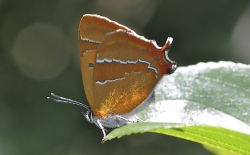 | 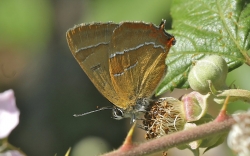 | 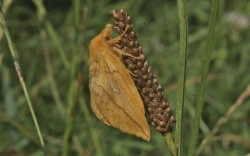 |
| Brown Hairstreak - Female Photo © Colin Baker | Brown Hairstreak - Male Photo © Colin Baker | Drinker Moth Photo © Colin Baker |
Silver-Spotted Skipper on Oxenbourne Down. I've spent several hours today, stalking the lovely Silver-Spotted Skipper, and I’m pleased to say this was the best count of this species on this downland for over a decade for me. Whether or not it’s making a comeback due to milder winters, and warmer springs, or I was at last looking in the right place, or I could put it down to a new prescription of glasses! However whatever it was I counted (21) a modest count probably as I think there probably were more here but you have to careful about counting twice. These were spread all over the first down next door to the A3 Motorway. There were Skippers buzzing all over the place, the Small Skipper is still very much in evidence, and a few Essex thrown in for good measure. But the Silver-Spotted Skipper was the 'Greyhound' of the down chasing anything and everything that came anywhere near it. I saw several females egg-laying, but whether they were just going through the motions I'm not sure, as they were nowhere near a rabbit scrape where the food-plant Sheep’s fescue grows. Other gems seen were Dark-Green Fritillary (1), Holly Blue (1) Chalkhill Blue (THOUSANDS) Common Blue (30) Brown Argus (6) Brimstone (14) Small Heath (1) Marbled White (10) Painted Lady (1) Many Gatekeepers, Meadow Browns, and six-potted Burnet Moths with a few Silver-Y Moths. [Posted by Ashley Whitlock]
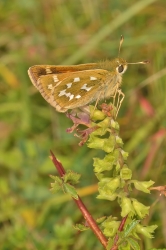 | 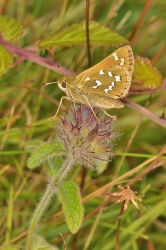 | 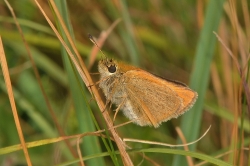 |
| Silver-Spotted Skipper Photo © Ashley Whitlock | Silver-Spotted Skipper Photo © Ashley Whitlock | Essex Skipper Photo © Ashley Whitlock |
Chalton Down Photos. After editing a few of my photos from my visit to Chalton Down on 28th July. [Posted by Richard Symonds]
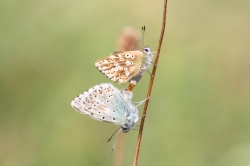 | 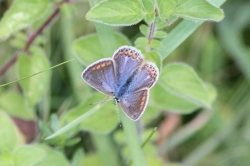 | 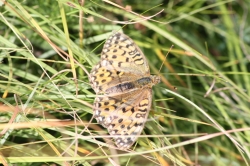 |
| Photo © Richard Symonds | Photo © Richard Symonds | Photo © Richard Symonds |
Chalton Down. After an overcast morning, I visited Chalton Down (SU736156) in company with my father and my wife, where we saw 19 different species. Chalkhill Blues were out in force, I counted 269 with five mating pairs, the true number probably at least half that amount again. Along the top of the slope 2 Clouded Yellows and 4 Dark Green Fritillarys were flying. Only 3 Marbled Whites were seen. Fresh Common Blues of both sexes, Brown Argus and a single Small Heath were also seen. Other species recorded were: Brimstone, Large White, Small White, Meadow Brown, Ringlet, Gatekeeper, Small Copper, Red Admiral, Small Tortoiseshell, Peacock, Large Skipper and Small Skipper. [Posted by Richard Symonds]
WLH at Stockbridge Down. Quick lunchtime trawl today, revelaled Brimstone, Meadow Brown, (50+), Gatekeeper (50+), Small White (12), Large White (7), Peacock (20+), Small Tortoiseshell (5), Red Admiral (3), Adonis Blue (2), Chalk Hill Blue (100+), Small Skipper (20), Essex Skipper (2), Marbled White (1), Dark Green Fritillary (4 - very tatty!), 5-spot Burnet (lots), and White-letter Hairstreak (1) - chance encounter, not particularly close to the alleged colony 'up the farm track'. The singleton (in VGC) flew across my path, and settled for a quick sup of bramble nectar - just enough time to get 3 reasonable photos (& 5 out of focus...). Sadly, the diagonal bit of dead grass was in all shots. [Posted by Jon H-D]
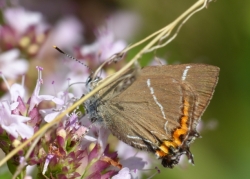 |
| WLH @ Stockbridge Down Photo © Jon H-D |
Brown Hairstreak Shipton Bellenger. I took a chance this morning to go Shipton Bellenger to try for Brown Hairstreak and by late morning, I had managed to see 3 plus high up in an Ash tree, a poor record shot of one attached, also seen a Holly Blue. [Posted by Mike Duffy]
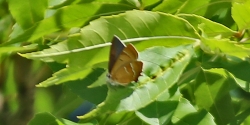 | 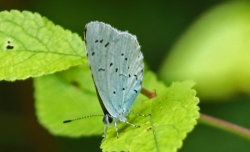 |
| Brown Hairstreak Photo © Mike Duffy | Holly Blue Photo © Mike Duffy |
Oxenbourne Down. I spent several hours exploring the more remote areas of the site today and counted 22 species. Chalk Hill Blues were probably in their hundreds up the top. I counted in excess of 50 Peacocks as well as Red Admiral, Comma, a fresh Small Tortoiseshell and 3 Painted Lady. Small, Large and Green Veined Whites were present as well as good numbers of Brimstone. I counted almost 30 silver Washed Fritillaries some in quite good condition. Common Blues were doing well including some unusually marked examples. Marbled Whites are still plentiful as well as lots of Gatekeepers and Meadow Brown. Small and Essex Skippers are mostly quite faded but there are a few fresh ones. Silver Spotted Skippers are still only out in small numbers perhaps 6 males seen today but again no females. I also saw 3 Brown Argus and Small Copper, Ringlet and Holly Blue singly. A beautiful day. [Posted by Paul Harfield]
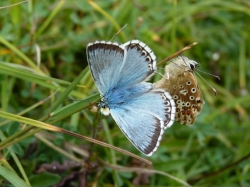 | 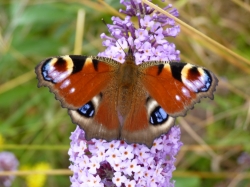 | 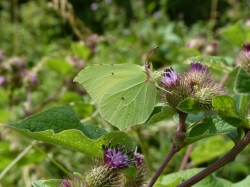 |
| Photo © Paul Harfield | Photo © Paul Harfield | Photo © Paul Harfield |
Chalk hill blue explosion. At Arreton Down Isle of Wight this afternoon there were possibly 10,000 chalk hill blues or more together with 2 clouded yellows. 1 small skipper, 1 small tortoiseshell, 2 red admirals, 1 peacock, 4 marbled whites, 1 common blue, 1 green-veined white, 3 large whites, 2 commas, many gatekeepers and meadow browns and 1 brown argus. [Posted by Ian Pratt]
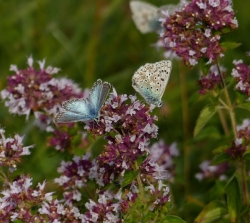 | 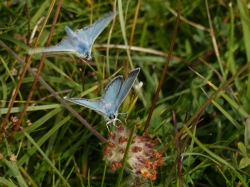 | 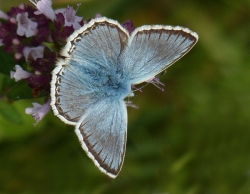 |
| Photo © Ian Pratt | Photo © Ian Pratt | Photo © Ian Pratt |
Brown Hairstreak. Chris Webb, NT warden for Selborne, saw a male Brown Hairstreak on Selborne Common early on the morning of Thurs July 24th.
Today, I visited Shipton Bellinger Roughs, near Tidworth, arriving in thick but warm cloud at 8.30. Brown Hairstreak was already active, though it had probably only just got up. The cloud soon broke. In two hours I saw some 25 males, dashing about over the sloe tangles. They were quietening down when I left, and setting up territories on ash, field maple and even a tall outgrown buckthorn bush. No females were seen, though I'm sure some are out.
This is a promising start to the Brown Hairstreak season (I saw a dozen males and a female in an hour and a half early yesterday morning in North Wilts). Looks like it's quite well out already... [Posted by Matthew Oates]
Wall Browns at Keyhaven. At least 10 Wall Browns along the cycle track (ancient highway)from Keyhaven to Lymington early this morning - basking on the pebble pathway along most of the route to the first turn to the sea wall. [Posted by Mark Wagstaff]
Long-tailed Blue at Magdalen Hill Down. On a family visit to Winchester visited Magdalen Hill Down this morning. A female Long-tailed Blue on the exposed area of chalk was unexpected. Also there two Brown Argus, three or more Small Blues, one Small Copper, plentiful Chalkhill Blues. [Posted by Martin Daniel]
Buddleia Police next?. Daily Mail readers on Wednesday 23rd July might have read Nigel Colbourn's entertaining article about the war that Defra might be about to leash on our butterflies favourite Buddleia.
http://www.dailymail.co.uk/debate/article-2702210/Hands-Britains-buddleias-Its-fragrant-favourite-butterflies-love-says-NIGEL-COLBORN-So-Government-got-buddleia.html
It's worth reading! [Posted by Lynn Fomison]
Purple Emperor at Goose Green. After editing my photos from my holiday, here is the battered male Purple Emperor which was flying at Goose Green Inclosure, Alice Holt Forest. [Posted by Richard Symonds]
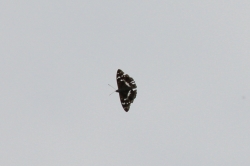 | 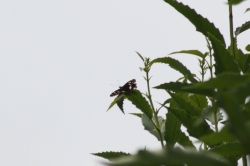 |
| Last Emperor at Goose Green. Photo © Richard Symonds | Emperor at rest. Photo © Richard Symonds |
Camberwell Beauty. As we cycled through Whitehill on the way to Woolmer Forest, my wife, Lyn, saw a definite Cambererwell Beauty fly across the road, northwards. Described as very large (at least as big as a Peacock), very dark with white/yellow frilly edges. (She is very familiar with White Admiral from our local Alice Holt Forest.) We had a look around the gardens in the direction it headed but to no avail. Why is there never a buddleia bush when you need one ? Stephen Miles - if you are reading this it could have flown through your garden !
To my great regret I was doing the man thing and cycling in front and as a result missed it.
This was at SU787341 - along Firgrove Road at the Firgrove Turn. [Posted by Steve Mansfield]
Adonis blue second brood. I saw three Adonis blues at Bonchurch Down this morning. [Posted by Ian Pratt]
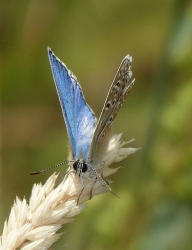 | 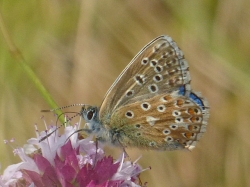 | 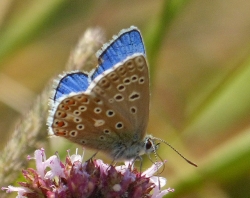 |
| Adonis blue Photo © Ian Pratt | Adonis blue Photo © Ian Pratt | Adonis blue Photo © Ian Pratt |
New Forest BC meeting. Many thanks to the group visiting Hawkhill Inclosure and surrounds in the heat today. We saw 14 species of butterflies (+ a few others in my garden for me before setting out). One possible Dark Green Fritillary noted, but many Grayling were flying on the heathlands and some Silver-studded Blue, mainly tatty now but elsewhere in the New Forest some are freshly emerged. Yesterday's brief rain shower had clearly prompted some butterflies to hatch, also Six-spot Burnet. As always, various other insects to observe. [Posted by Paul Brock]
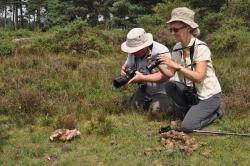 |
| Grayling photographers at work Photo © Paul Brock |
The King is Still Alive at Goose Green - Just. After visiting Straits Inclosure in the morning, my father Roy Symonds, my wife and I visited Goose Green Inclosure to seek out the last Purple Emperors.
Arriving at around 13.25 the weather was very humid and hot with temperatures reaching 27 degrees, but soon there was some cloud cover. This soon passed and as the sun appeared once more there was still no sign of any Emperors around the master Sweet Chestnut tree. We waited for about 10 minutes until finally a male flew out of the tree flying across the road and back, returning to settle on a leaf at 13.45. He flew out whenever a passing plane flew near and even chased a Wood Pigeon as it flew over his tree! Flights were made at 13.51, 13.52, 13.55, 1356, 1357 and 13.59 when we left a few minutes later. I got several aerial photos of this male, including sitting on a leaf opposite the master tree which clearly showed that he had suffered wing damage with four missing areas of wing across his hindwings.
Other species seen were Meadow Brown, Ringlet, Speckled Wood, Silver Washed Fritillary and 4 Purple Hairstreaks. [Posted by Richard Symonds]
Straits Inclosure, Alice Holt Forest. On trip up from Cornwall, my wife and I visited Straits Inclosure today together with my father, Roy Symonds and Colin Baker to see if Purple Emperor's were still flying. Sadly we saw no sightings in Straits, where the temperature reached 24.5 degrees. Around 50 Silver Washed Fritillarys were seen as well as 8 White Admirals which were still in surprisingly good condition. Around the tops of the Oaks a total of 4 Purple Hairstreaks was seen, while several fresh Common Blues of both sexes were also seen. Other species recorded were; Small White, Large White, Green Veined White, Meadow Brown, Ringlet, Gatekeeper, Speckled Wood, Small Tortoiseshell, Red Admiral, Peacock, Large Skipper and Small Skipper [Posted by Richard Symonds]
plant recommendation and clearwing moth. Plenty of Gatekeeper sightings in my Havant garden at the moment: up to 4 in our relatively small garden in a built-up area. As is well known, they are very attracted to native Marjoram - I have just two clumps of 3, 'Chelsea chop' them in May, and they work a treat (covered in Honeybees too). However, a new plant in this year's hanging baskets, Bidens 'Pirates Pearl', has proved most attractive to the Gatekeepers (and also Honeybees and various hoverflies). Pic attached.
Had a very brief sighting of a Red-Belted Clearwing (also on the Bidens) whilst watching the Gatekeepers this afternnon. Dashed in for camera, but it had gone. First sighting in about 3 years - we have a mature Apple, as does my neighbour. [Posted by Martin Hampton]
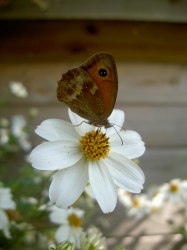 |
| garden Gatekeeper on Bidens 'Pirates Pearl' Photo © Martin Hampton |
Silver-washed Fritillary laying eggs in garden. My father and I were delighted that yesterday afternoon, this Silver-washed Fritillary spent a good 15 minutes or so (at least), laying eggs in his garden in Rownhams, Southampton. She was laying the eggs on and around a retaining wall, which is near a patch of violets. [Posted by Hazel Taylor]
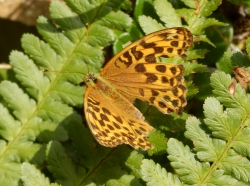 | 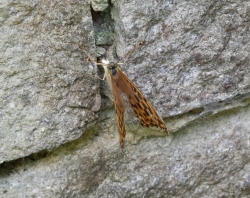 | 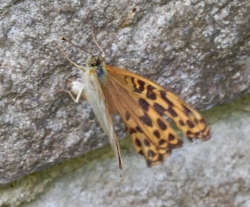 |
| Silver-washed Fritillary Photo © Hazel Taylor | Egg laying in crevice Photo © Hazel Taylor | Egg laying on surface of stone Photo © Hazel Taylor |
Clouded Yellow at Cheesefoot Head. Two Clouded Yellows were seen on private land just south of Cheesefoot Head along with a good selection of more common butterflies. [Posted by Dave Pearson]
Old Winchester Hill. Went to Old Winchester Hill today to look for the Silver-Spotted Skipper but alas I had no luck, there are still too many Small Skippers flying about which makes it more difficult. However there were still (5) Dark Green Fritillaries on the wing, one male was still in pretty good condition for its age. Many Marbled Whites still on the wing, and the Chalkhill Blue was uncountable, the car-park down was literally shimmering with them! I managed to find one Small Blue, which I do quite often when I visit this site, where they come from I do not know as I've never found any Kidney Vetch on the site, and I've only ever found one or two, never a small isolated colony of a dozen or more like most sites have with this species. I also watched a female (pale) Clouded Yellow of the form "helice" searching and ovi-positing but I didnt find the eggs. [Posted by Ashley Whitlock]
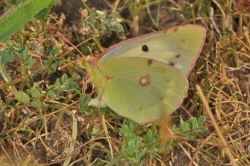 | 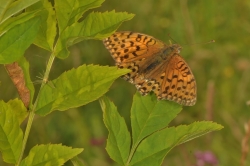 | 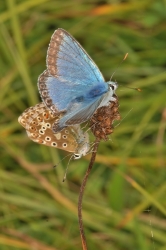 |
| Clouded Yellow (female) f. helice Photo © Ashley Whitlock | Male Dark-Green Fritillary Photo © Ashley Whitlock | Chalkhill Blues Mating Photo © Ashley Whitlock |
Stockbridge Down delivers again!. A relaxing morning spent in the company of hundreds of Chalk Hill Blue on Stockbridge Down, including several mating pairs. The Marbled White are still hanging on, and several female Dark Green Fritillary were also flying. A few Small Copper were also seen, along with the ubiquitous Meadow Brown and Gatekeeper. As usual, the skippers put on a display and I watched a Small Skipper ovipositing - reliving my previous visit here! However, this time, on checking the sheath into which she'd popped her eggs, was an amazing collection of no less than 17 eggs! Based on their colour, I'd say these had been laid at different times by at least 4 different females. [Posted by Pete Eeles]
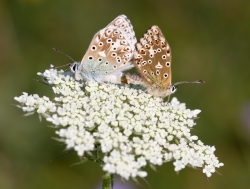 | 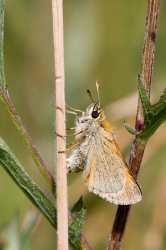 | 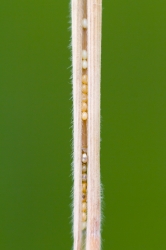 |
| Chalk Hill Blue (mating pair) Photo © Pete Eeles | Ovipositing Small Skipper Photo © Pete Eeles | Omelette anyone? Photo © Pete Eeles |
Common Grayling at Browndown Gosport. This lovely butterfly - the first that I have ever seen and photographed in UK - was on bundles of heather on the stonier part of Browndown. I counted three separate insects. Last week only one was seen. [Posted by Francis Plowman]
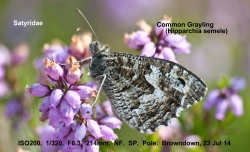 |
| Photo © Francis Plowman |
Noar Hill. Dark Green Fritillary 1, Brimstone 1, Marbled Whites 20, plus others. [Posted by David Buckler]
Garden Wonders. I have just visited a friends garden which backs onto Portsdown Hill, and his garden is about an acre of land, and he leaves his garden basically to nature, what he hasn't got in his garden isn't worth knowing about. Butterfly wise he has dozens of Gatekeepers, Meadow Browns,Brimstones, and Skippers, and these all breed there as well. A couple of years ago he even had a Silver-Washed Fritillary in the garden and she layed her eggs on a tree, where he had a flush of violets. He also has a moth trap out at least once a week, and we looked at it today and I took some photographs of some of them, using a muslin net to harbour the hawk-moths from hungry Robins patrolling up and down the garden. His garden has been awarded a best for Nature conservation by the Hampshire and Isle of Wight Naturalists trust. [Posted by Ashley Whitlock]
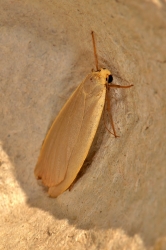 | 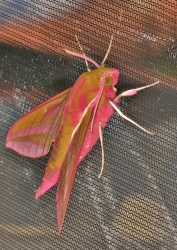 | 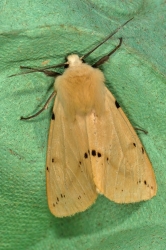 |
| Common Footman Photo © Ashley Whitlock | Elephant Hawkmoth Photo © Ashley Whitlock | Buff Ermine Photo © Ashley Whitlock |
New Forest Grayling. I visited Hawkhill Inclosure and Hatchet Moor today and I was pleasantly surprised what I saw. In the Woodland just one single Silver-Washed Fritillary, several Silver-Studded Blues, but all the Marbled White and Dark-Green Fritillaries have gone, but the Gatekeeper was everywhere. On the Heathland the Grayling is King it was 'very common ‘I saw upwards of 50 without any effort at all ghosting like bats over the bells heather. Also I could still see many Silver-Studded Blues (20) and here there was one female and male Dark-Green Fritillary as well, still on the wing, looking a little jaded and forlorn. I actually went to have at look at some parts of the Forest where in 2015 I shall be looking for the Purple Emperor, starting at Ashurst where it was last seen on the ground at Costicles Inclosure a few years ago. [Posted by Ashley Whitlock]
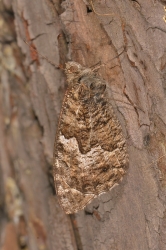 | 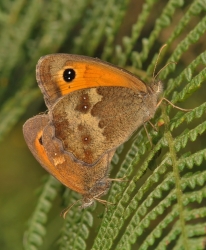 |
| Grayling on Douglas Fir tree trunk Photo © Ashley Whitlock | Mating Gatekeepers Photo © Ashley Whitlock |
Emperor at Silchester Roman Town. Went looking for white-letter hairstreaks on the wych elms at silchester roman wall, there was feeding damage on the leaves consistent with this species but could not positively ID and adults with so many purple hairstreaks flying around the adjacent oaks, on the way back to the car park a female purple emperor was flying around some sallows so this was a bonus. [Posted by Graham Dennis]
Oxenbourne Down. I made a brief visit at lunchtime in the hope of catching some Silver Spotted Skippers. Everything was very active in the baking heat between midday and 1pm. I managed 4 male Silver Spotted Skippers but no females. Plenty of Chalk Hill blues mostly male but with good numbers of females. I saw several mating pairs of both Chalk Hill Blue and Gatekeeper. Also seen were several fresh Common Blues male and female, Small and Esssex Skippers, Peacocks, Meadow Brown, Large Whites,Small Whites, Green Veined Whites and a single Red Admiral and Dark Green Fritillary. [Posted by Paul Harfield]
Portsdown Hill. Roy Symonds reports he visited Portsdown Hill (East) (SU657063) where he saw 3 male Chalkhill Blues along with Brimstone, Small White, Meadow Brown, Speckled Wood and Small Skipper.
Next over the road at Fort Widley (SU657066)he saw 2 male Chalkhill Blues along with 5 Marbled Whites. Other species present were Small White, Meadow Brown, Ringlet, Gatekeeper, Speckled Wood and Small Skipper. [Posted by Richard Symonds]
Chalton Peak. Roy Symonds reports he visited a slope near to Chalton Down known as Chalton Peak which is situated immediately above Woodcroft Farm (SU736160). This site has little or no grazing but is interesting to see the difference in habitat in such close proximity to a "good site". A total of 7 species were seen (Brimstone, Small White, Meadow Brown, Marbled White, Gatekeeper and Small Skipper)including a single male Chalkhill Blue. [Posted by Richard Symonds]
Chalton Down. Roy Symonds reports that at Chalton Down (SU736156) he saw 46 Chalkhill Blues including one female, the first of the sex he had seen this year. A few Marbled Whites were still to be seen with 23 Gatekeepers and 11 Small Skippers. Other species found were Brimstone,Small White, Meadow Brown, Ringlet and Peacock. [Posted by Richard Symonds]
Record Species count. Yesterday I visited a site in the Meon Valley and counted 22 species a record for me on a downland site, species seen were Small Tortoiseshell, Speckled Wood, Marbled White, Large White, Small White, Gatekeeper, Brimstone, Peacock, Small Skipper, Large Skipper, Essex Skipper, Small Heath,, Meadow Brown, Ringlet, Dark-Green Fritillary, Common Blue, Small Blue, Chalkhill Blue, Green-Veined White, Red Admiral, and last but not least Comma. Notes on the site is that it’s becoming very overgrown, hence the Dark Green Fritillary numbers have crashed, only seeing (5) on the other hand the owner of the site has been wanting to get the Chalkhill Blue at the site for many years, and today was the first time Ive ever seen it here, although I dont know where it would breed as there is no real areas suitable for breeding to speak of at the moment. [Posted by Ashley Whitlock]
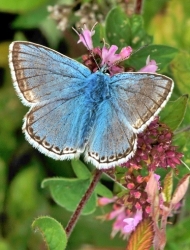 | 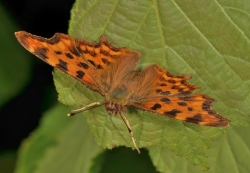 |
| Chalkhill Blue Photo © Ashley Whitlock | Comma Photo © Ashley Whitlock |
Mass Peacock emergence. Over 60 Peacocks counted on the Longstock Park buddleja collection, tenfold more than last Sunday. Few other vanessids however. Top scoring cultivar was B. davidii 'Orchid Beauty' with 7 Peacocks and 1 Small Tortoiseshell. 'OB' is not a buddleja of great horticultural merit; it has virtually no secondary flowering while the colour, to the human eye, is unremarkable. But the Peacocks love it. [Posted by Andrew Brookes]
The cinderella of heaths. Went for a walk over to Hogmoor inclosure where the army do armoured vehicle training vehicle training and new inner relief road is propose.Among the several species I saw Ringlet,Meadow Brown,Small heath and Grayling.By the way can you remove the spellcheck its irritating. [Posted by jim smith]
Stephens Castle Down. In the very hot afternoon sunshine at this location half a dozen very fresh male Common Blues were vigorously defending territory against each other and some very worn male Dark Green Fritillaries. Several fresh Peacocks and Brimstones were also in evidence. Plenty of Marbled White, Meadow Brown, Gatekeeper, Ringlet Small & Essex Skipper as well as single Large Skipper, Small Tortoiseshell and Red Admiral.
After visiting this site regularly for the last couple of years I recorded a Comma for the first time. This brings the total number of butterfly species I have seen here to 26. I also spotted a Hummingbird Hawk moth [Posted by Paul Harfield]
Magdalen Hill Down walk. The BC walk at MHD was well attended and the early clouds quickly dissolved. We saw 18 species of butterfly. The predominant species was Marbled White with Meadow Brown, Chalk Hill Blue and Gatekeeper also showing well. We also saw Essex Skipper, Small Skipper, Brimstone, Peacock and Red Admiral. Other species seen were three Small Blues, one Common Blue, two Brown Argus, one Comma and Large White, Small White, Holly Blue, Ringlet and Small Tortoiseshell. There were many 5-spot Burnet moths and micro moths flying. [Posted by Sue Lambert]
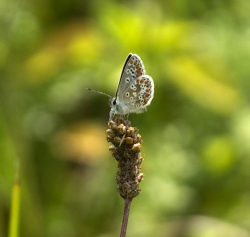 | 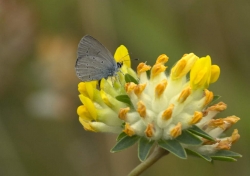 |
| Brown Argus Photo © Sue Lambert | Small Blue female egglaying Photo © Sue Lambert |
Southleigh Forest. male purple emperor still from assembly point during brief lunchtime visit 13:20-13:45 also several SWF [Posted by Peter Gammage]
Dark Green Doing well at Oxenbourne Down. This site in the 1980's and even in the 1990's had a very small colony of Dark Green Fritillaries, but over the last two seasons, their numbers have increased, by a large margin, where I used to count ones and two's well today was the best count I've ever had at the site I counted twenty. Marbled Whites are still in good numbers, but the Small Skipper was in the hundreds, all over the down. The Chalkhill Blue is starting and was seen on the first part of the down counting upwards of 50+ at least. [Posted by Ashley Whitlock]
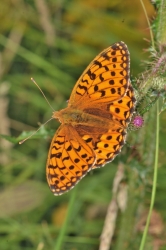 | 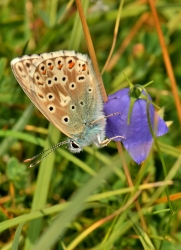 | 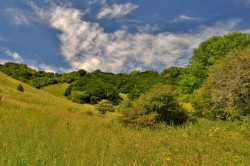 |
| Dark-green Fritillary Photo © Ashley Whitlock | Chalkhill Blue Photo © Ashley Whitlock | Oxenbourne Down Photo © Ashley Whitlock |
Fading in Havant Thicket. Visited Havant Thicket today with plenty of cloud cover to start with, but this soon burnt away to leave a very warm morning. There were good numbers of Gatekeepers and Small Skipper around and a few White Admirals. Silver-Washed Fritillaries appeared when it warmed up enough. At Bells copse I saw one Male Purple Emperor at 1050 appearing along the oak edge of the main ride, but he quickly disappeared. There didn't seem to be any at the Assembly points probably due to the storms of the 17 July. [Posted by Ashley Whitlock]
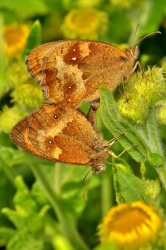 | 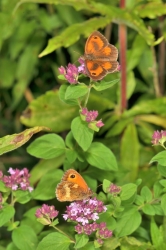 | 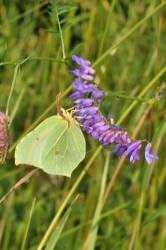 |
| Gatekeeper Mating Photo © Ashley Whitlock | Gatekeepers Feeding Photo © Ashley Whitlock | Brimstone Photo © Ashley Whitlock |
Havant Thicket. I brief lunchtime visit to Horsefoot Hill between 13:15 and 13:45 produced a single male Purple Emperor still holding territory in the tops of the birch and briefly chasing off a second male. [Posted by Peter Gammage]
Dark Green at Chalton Down. Roy Symonds reports he revisited Chalton Down to look for Dark Green Fritillarys. He was in luck and observed first a pair flying together before a third appeared and landed long enough for him to get a photo. Other species seen were Brimstone, Small White, Meadow Brown, Ringlet, Gatekeeper, Marbled White, Chalkhill Blue and Small Skipper. [Posted by Richard Symonds]
Still at Goose Green. I had to go to Reading today, and on the way back I went via Farnham, so I called in to Goose Green Inclosure and at 1545 there were still two males on station in the Sweet Chestnut Tree Vista, both were doing regular patrols around the vista and meeting up and still bashing each other just like young kids. I watched them for about 20 minutes, and left the Inclosure at 1600 with one of the males perched on one of the young Beech trees at the summit. I think they will last until the Thunder storms arrive tonight and again Friday where they are very vulnerable in the canopy.
Just to note I think it highly unlikely the Field Trip to West Wood will go ahead as there is forecast some mighty storms crossing the south of England on Saturday Morning causing flash floods. Please phone me if you were attending this field trip to make sure thank you. [Posted by Ashley Whitlock]
Fading Purple. On one of the best days of the summer in 2014 the Purple Emperor is probably all but finished in Alice at least. In Straits Inclosure there was one male seen crossing the main ride at 1010 today. In Abbotts Wood Inclosure I saw one male oak edging at the main triangle crossways heading west at a great rate of knots at 1115, and when I was on the way out to the small car-park I was overflown by a magnificent female Purple Emperor, she saw me and consequently dived into a Hazel Thicket, and I never saw her again, at 1200. At one of the Assembly Points where I took my field trip party on Saturday in Abbotts Wood Inclosure there were three males on station, but today alas there was only one, he seemed quite content flying around his vista, and settling down on the pine leaves. A lot can happen in the four days to these male emperors since we were all there gazing up at the antics of these wonderful insects,which probably equates to a sixth of their life span, I never looked in Goose Green Inclosure but I suspect there is still a couple a males still contesting the air-space in the Sweet Chestnut Vista. [Posted by Ashley Whitlock]
Yellow, Green and Blue at Chalton Down. Roy Symonds reports that he visited Chalton Down (SU736156) again today where the temperature was 23 degrees. He was delighted to see a Clouded Yellow fly along the top of the ridge heading North. A similar sighting of a Clouded Yellow was made by him and myself on 4th August last year at this site. Nearby in an area of scrub, a Dark Green Fritillary landed briefly for identification before taking flight once more. Chalkhill Blue numbers continue to increase with 27 males recorded. Other species present were Brimstone, Large White, Small White, Meadow Brown, Ringlet, Marbled White, Gatekeeper, Small Skipper and a single faded Large Skipper. [Posted by Richard Symonds]
White Admiral larva behaviour. I've been following the emergence and subsequent development of a White Admiral larva. I managed to follow it for over a week before it simply disappeared! But what I found absolutely fascinating (and not something I've ever seen recorded) is that the larva doesn't simply move to the tip of the leaf and start feeding (leaving the midrib intact and leaving characteristic feeding damage) but deliberately constructs a platform, made from silk and frass, at the tip of the leaf. [Posted by Pete Eeles]
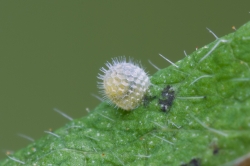 | 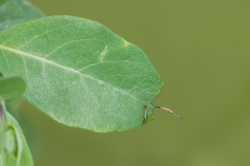 | 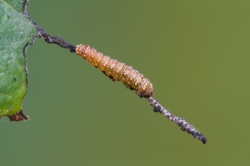 |
| White Admiral egg Photo © Pete Eeles | Platform construction underway! Photo © Pete Eeles | Closeup Photo © Pete Eeles |
Silver-washed Fritillary spectacle. I'm very lucky to live near to Pamber Forest - one of the best sites I know for Silver-washed Fritillary and White Admiral. I recently spent a very enjoyable hour at the edge of some woodland, where female Silver-washed Fritillary would nectar on bramble and rest (while not being hassled by males) before launching themselves into the woodland where they would sniff around on the forest floor for violets, before landing on a nearby tree trunk and deposit a single egg. There was lots of "oviposturing" going on where, despite going through the motions, no egg was laid. I was also surprised to find that several eggs were laid on the moss covering the bark, rather than the bark itself. Eggs were laid at all heights, from 1 inch off the floor, up to 2.5 metres up. Shots below show the general scene of one of the eggs, laid at the base of a tree and where, following egg-laying, I found another egg! I then had a good look around on some of the other trees in the vicinity and turned up several more eggs ... they were a lot easier to find than I was expecting! [Posted by Pete Eeles]
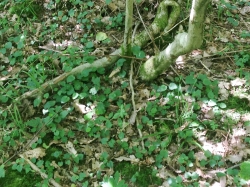 | 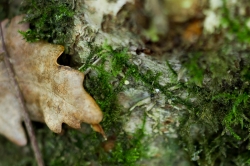 | 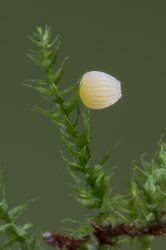 |
| Common Dog-violet Photo © Pete Eeles | Silver-washed Fritillary egg Photo © Pete Eeles | Silver-washed Fritillary egg Photo © Pete Eeles |
Silver-spotted Skipper. Managed to photograph this tonight on Stockbridge Down. [Posted by Craig Richardson]
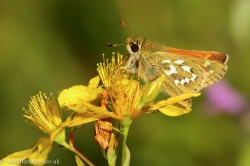 |
| Silver-spotted Skipper Photo © Craig Richardson |
Old Winchester Hill NNR 60th Anniversary!. Please note that Friday 18 July - Thursday 24 July sees Old Winchester Hill NNR 60th Anniversary celebrations! Come & celebrate 60 years of Old Winchester Hill being a National Nature Reserve! Full details on the Hampshire events page. [Posted by Pete Eeles]
Purple Ladies. In very cloudy weather and sometimes good weather conditions, I visited Creech Wood today and other woods in the vicinity. I spent up to two hours looking along the wayleaves without success. When I got back to my car in the small car-park I started tucking into my banana, when I just happened to look up, and there bold as brass was a Emperor very skittish in an Oak tree, I think it was a she judging buy its mannerisms and the size gave it away once I saw it fly, it flew around the car-park over the top of a large oak and then came back over the gate of the entrance and then settled back in the oak on the left again. I could see her plain as a Pike staff, on an oak sprig. I went to get my bins and as I came back she decided to move over the road, and headed for a large Ash tree. In this area I have seen females looking in the hedgerows, and the sallow content is phenomenal in most of the hedgerows in this area and my guess is this is what she would be doing when the time was right. I then moved onto Huntbourne Wood a Private Wood and here I saw a female flying in and around a small Oak in the main ride opposite the main Assembly Point Oaks, of which there was no activity, at the time.There is phenomenal areas of Sallow in this wood as well. [Posted by Ashley Whitlock]
Comma laying. A couple of years ago Dave Green showed me Comma larvae feeding on Golden Hop in his garden so Lynn bought me one and planted it just outside the back door. I watched a female Comma on it just now flying around and choosing a leaf on which to lay. It only took a second once she decided. [Posted by Tim Norriss]
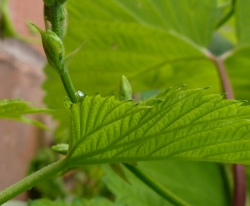 |
| Comma egg on golden hop Photo © Tim Norriss |
Hillier Gardens mothing. We left four moth traps running overnight last Friday at Hillier Gardens, Ampfield and went through the contents in the morning to show to the public. We caught 154 species which was a good count considering that it was near full moon. The most striking ones for the children were Privet Hawk, Elephant Hawk and two Pine hawk-moths but also Large and Common Emerald, Dark Spectacle, Four-spotted Footman, Coxcomb Prominent, Festoon and lots of micros most notable amongst which were Orthotaenia undulana, Pammene trauniana and the third Hampshire record of Metalampra italica whose larvae are found in dead oak. Do consider visiting Hillier Gardens. Annual membership entitles you to free entry into nine other Top Hampshire Attractions plus other gardens around the country including Kew. Do pay a visit. http://www3.hants.gov.uk/hilliergardens.htm [Posted by Tim Norriss]
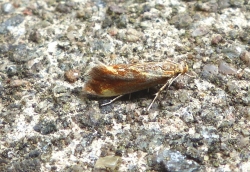 | 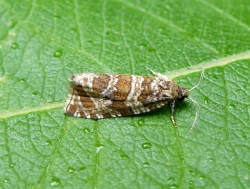 |
| Metalampra italica Photo © Tim Norriss | Orthotaenia undulana Photo © Tim Norriss |
Lovely Lowsley. Today discovered an embankment on Lowsley farm,Liphook where you are permitted to walk at the moment.There I saw 3 Marbled Whites,lots of skippers and a small tortoiseshell.Definitely needs some recording there and preserving as a large part of this farm is becoming a housing estate. [Posted by jim smith]
Bell's Copse SU7010. We went for a walk around Bell's Copse and saw 2 male Purple Emperor one of which came down from the master tree,and settled on some of the sallow giving us some good views before flying back up into the oak tree.(Barry and Margaret Collins) [Posted by Barry Collins]
Moths at Rooksbury Mill LNR. A quick visit today to my local nature reserve produced nineteen moth species at the lights of the underpass including this Black Arches. I was studiously ignored by most people walking past as I peered at the walls or scribbled in my notebook - can't imagine why! I expect they, like me, missed the two otters playing in the small lake just after I left. [Posted by Tim Norriss]
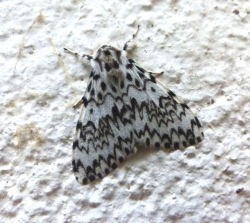 |
| Black Arches Photo © Tim Norriss |
Chalk Hill Blues at Chalton Down. Roy Symonds reports today that he visited Chalton Down (SU736156) to check for Chalk Hill Blues. A total of 17 males were seen, although the slopes here have now started to get long grass growing among the vetch. I don't know if the rabbit population here has been affected by disease. Hopefully numbers will still continue to increase with estimates of usually around 400 to be seen by August. Marbled Whites are still flying here 24 being noted along with 2 fresh male Brimstones. Other species seen were Small White, Meadow Brown, Ringlet, Gatekeeper, Large Skipper and Small Skipper. [Posted by Richard Symonds]
Emperor Egg. After briefly meeting up with Ashley and his field trip at Abbots Wood on saturday I cycled off to to see if I could locate any female Purple Emperors. These tend to be active around noon, as they seek out Sallows shaded from the midday sun, in which to lay their eggs. I wasn't very hopeful as I have seen comparatively very few Emperors at all in Alice Holt this year, at most four or five males per visit, and only the briefest sighting of a female at Bentley Wood.
However, as I was scanning a group of mature Sallows where I had seen numbers of females in the past, a movement caught my eye around an adjacent, very small, sapling. Sure enough it was a female emperor flitting around the inside of the 'bush' as they do. For a very large butterfly (they are probably the second largest after the Swallowtail) they seem just to 'materialise' out of the ether and vanish just as quickly and are extremely hard to hard to follow once they have 'struck' a Sallow.
She was at head height in the most unlikely bush, only about 8ft high with the thickest branch only the diameter of my little finger. As I watched, through my binoculars, she curled her abdomen and appeared to be laying an egg. I have seen this many times before as they seem to go through the motions and 'pseudo' lay before actually finding a suitable leaf on which to lay. This time I was in luck - I could clearly see the emerald green egg she had just laid. She disappeared just as quickly as she had materialised and I managed to grab a couple of quick shots in quite windy conditions. One for the future?
I also visited Havant Thicket today and there are many hundreds of Gatekeepers, Meadow Browns and Ringlets here along with good numbers of Small and Large Skippers, a couple of Silver Washed Fritillaries and singletons of male and female Emperor. [Posted by Mark Tutton]
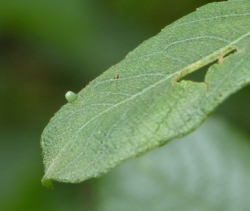 |
| Fresh iris egg Photo © Mark Tutton |
Purple Whiteley Pastures. I had a quick look around Whiteley Pastures this morning, the amount of time spent in the wood now is governed on how long you get in the car-park which is only three hours now (free). This is the only wood I know of where you can see Purple Emperors with the smell of 'Costa Coffee' hanging in the air. I have fond memories of this wood when it was just woodland, and 'Whiteley Village' was just somebody's fantasy, well back in the 1980's, well I even remember the Small Pearl-Bordered Fritillary and Pearl here. Then the Sallows all got ripped out in the mid-eighties, and then the Whiteley conurbation started eating away at it, so what are we left with. Well still one of the best woods in Hampshire, and the good news is the Sallows are regenerating where I used to see the Emperor imbibing on the ground, when I used to visit in the eighties. There doesn't seem to be so many Silver-Washed now, and hardly any White Admiral. The Emperor I'm afraid was very shy, and with the advent of them being on the wing now the best part of three weeks, they are probably getting heavily predated, with an almost constant patrolling up and down the rides of Emperor Dragonflies, and the constant chatter of Long-Tailed Tits and Blue Tits in the Oak canopy, probably picking off an unsuspecting Emperor asleep in the Canopy. However just as Id given up on it, as I was just leaving, a male sailed into view, and meandered over the oak canopy in the main ride, and flew out over a large Oak at 1145. There are excellent counts of Peacock well into the twenties, and Gatekeepers are building up their numbers as well. [Posted by Ashley Whitlock]
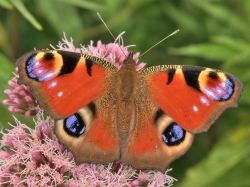 | 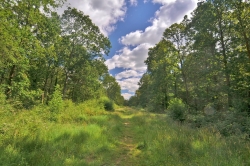 |
| Peacock Photo © Ashley Whitlock | Whiteley Pastures Photo © Ashley Whitlock |
Purple Emperor. Purple Emperor - female on shore of Southampton Water (taking salt?) at Royal Victoria Country Park, Netley (SU462080) between 10.00-10.15 a.m. today before flying into the wood.I haven't seen Purple Emperor in this area before. Unfortunately, the camera was in the car! [Posted by Andrew Collins]
Havant Thicket. Roy Symonds reports visiting Havant Thicket today. Despite several attempts now he saw no Purple Emperors, however a single White Admiral, 7 Silver Washed Fritillarys and 3 Marbled Whites were seen. Other species present were Small White, Meadow Brown, Ringlet, Gatekeeper, Large Skipper and Small Skipper. [Posted by Richard Symonds]
Large Tortoiseshell. Immaculate Large Tortoiseshell seen during a butterfly walk at Briddlesford Copse, a private woodland near Wootton, IoW, owned by the People's Trust for Endangered Species. Other species seen included numerous Silver-washed Fritillaries, Ringlets, Meadow Browns, Marbled Whites, Skippers, newly emerged Peacocks, but only 8 White Admirals. Ovipositing Red Admiral and Comma completed the tally. [Posted by Andrew Brookes]
grayling sighting. 2 grayling spotted at woolmer to left of railway track [Posted by jim smith]
summer brood holly blue. seen at the straits inclosure today [Posted by nick lawrence]
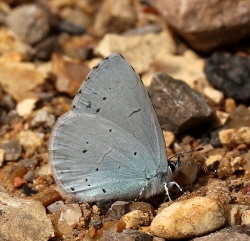 |
| Photo © nick lawrence |
Purple Creech Wood. After the third time of asking,I saw two Purple Emperors in Creech Wood today, one oak edging quite late in the afternoon heading east along the wayleaves at 1345 and then my wife saw an Emperor fly into a Scots Pine tree, at 1445 at the main car-park area, where there is possibly an Assembly Point. We also saw a new Common Blue and several Peacocks, with many Silver-Washed Fritillary's. There were no White Admirals seen. [Posted by Ashley and Jackie Whitlock]
Field Trip Abbotts Wood Inclosure. The Abbotts Wood Inclosure Field trip was a success, although we never had any Male Emperors down on the ground, we did encounter several Males embarking on Oak edging and some Sallow searching in the main ride from the small car-park on the south side of the wood. It was perfect weather for the Emperor, nil-wind good sunny and warm spells of sunshine. We encountered the Males at about 1120 and they were seen at regular intervals as we all stood in the triangle, at 1130,1140,1141,1150,1155,and at 1157. We probably saw upwards of 3-4,as its difficult assessing the fact you may be seeing the same one patrolling up and down, but there was one male with a torn wing, so he was definitely a different one for the list. One male did come over to us just above head height and disappear over the clear felled area, but he wasn't stopping around. We visited one of the lesser known Assembly points in the wood, and here we saw at least (3) males on station chasing each other, and settling in Douglas Fir trees and Oak at about mid-day.
In the afternoon we visited Goose Green Inclosure, and saw another 3-4 males on station, chasing each other and setting on the Sweet-Chestnut Trees on the main slope. We also saw a lot of Dragonflies in the main ride, a Red Kite spiralling over the wood, and a rare Hobby. Id like to thank all who came and made it a very enjoyable field trip. [Posted by Ashley Whitlock]
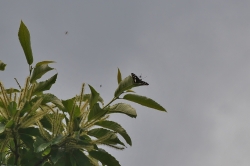 | 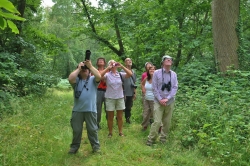 |
| Emperor at Goose Green being buzzed by flies Photo © Ashley Whitlock | There is an Emperor up there somewhere! Photo © Ashley Whitlock |
Bell's Copse & Havant Thicket SU7110. After having a good look around Bell's Copse during the morning,I then cycled east along the main track on the south side of Havant Thicket and at SU713104.I came to a sudden stop when I saw my first female Purple Emperor of the year she was very active visiting different sallows either side of the track during the time I was watching her,probably egg laying.Other highlights included 29 Silver-washed Fritillary,19 of which were recorded at Bell's Copse plus 3 White Admiral etc.Some of the goodies caught in my moth trap over night back at home in Leigh Park included a Reed Dagger,5 Elephant Hawk,Tawny-barred Angle,Coronet,True Lover's Knot,4 Buff Arches,2 male Festoon,Herald,European Corn-borer. [Posted by Barry Collins]
Seen at Woodend, Bere Forest. We saw 1 White Admiral which sat on my sister-in-law's hand for a minute ! Saw a few Meadow Browns, 4 Small Coppers, a few Whites, ! Peacock, 1 Brimstone and a fleeting glimpse of what might have been a Silver Washed Fritillary ! We had hoped to see these Fritillaries and have done so in previous years. Time around 1100. [Posted by Patrick Spence]
Hayling Island Cycle Trail. Roy Symonds reports walking the Hayling Island Cycle Trail (SU7110) from the car park opposite Victoria Road to the Station Theatre, West Town. Many Browns and Whies were seen along with a total of 51 Gatekeepers. Species noted were Brimstone, Large White, Small White, Meadow Brown, Marbled White, Speckled Wood, Red Admiral and Comma. [Posted by Richard Symonds]
Late Brimstone on Portsdown. Walking on Portchester Common in the morning to my surprise I found this Brimstone at rest at the top of the hill - reluctant to fly in the breezy conditions and clearly tired, I guess a very late spring emerger. [Posted by Chris Cobb]
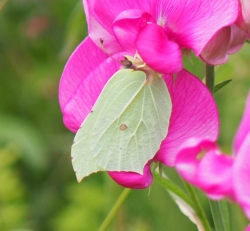 |
| Photo © Chris Cobb |
Ampfield Woods. 2 x Purple Emperor females basking on forest track.
15+ Silver Washed Fritillaries, including mating pair on the wing together, and possible Valesina at a distance (we have seen these before here nectaring on thistles) [Posted by Tim and Sue Graham]
Havant Thicket. Roy Symonds reports to me that he returned to Havant Thicket today where the temperature was 22.5 degrees. A staggering 56 Small Skippers were seen, including 12 imbibing from a small puddle. Also noted were 3 White Admirals and 15 Silver Washed Fritillarys. Other species present were Brimstone, Large White, Small White, Meadow Brown, Ringlet, Gatekeeper, Marbled White, Red Admiral, Comma and Large Skipper. [Posted by Richard Symonds]
Micheldever Woods. Biking along to Micheldever Woods mid-afternoon I was puzzled by the antics of a male Silver Washed Fritillary. It was flying very low over the sun-baked surface of the car park, tracking back and forth. It seemed to be chasing and challenging its own shadow immediately below? [Posted by R Bryant]
West Wood. I had intended to go to Alice holt today but as I headed up the A3 there was and obvious line of cloud that looked like east Hants and Sussex would be in gloom most of the day so on reaching the A272 I headed west to winchester and West Wood.Had my bicycle with me so after parking up I did a circuit of the main track without much joy, although it did turn up a nice valezina which didn't stop for a photo and a Golden Ringed dragonfly.
There seemed a distinct lack of Sallows - even less now that the FC have done their ride widening - but i did spy a narrow track that had some lovely broad leaved sallow on the south side so sat down to have some wine gums and a drink. No sooner had my bottom touched the floor than a male sailed along the ride at eye level at settled a bit further up the track for a few photos. A bit later on i found another seriously giddy on the main track and it ended up sitting on my toe for 30mins - obviously enjoying something! In all I saw four possibly five males but no females - also encounters a singe White Admiral reasonable numbers of Silver Washed Fritillary and pleasingly good numbers of fresh Small Tortoiseshell.
Later I moved across to Bentley Wood which was very disappointing revealing just a brief glimpse of a single female. [Posted by Mark Tutton]
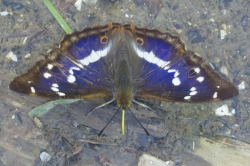 | 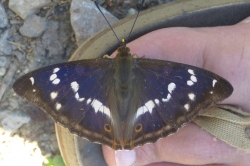 |
| Nice male in shade Photo © Mark Tutton | Another one on my toe! Photo © Mark Tutton |
Purple notes. These notes are from two woods which have been visited this year so far with a lot of success, I was in Winchester yesterday on business, so in the morning I visited West Wood and saw (3) males all in the air as it wasn't particularly good weather in morning with a strong breeze and only partially sunny at times. It was better in the afternoon when I had to visit Winchester, always the way! And today I visited Havant Thicket again and three males were seen in particularly good weather although it was breezy in the canopy. One male was seen in the same oak in the same ride, must be his particular favourite, and at roughly the same time about 1115, I never saw any in Bells Copse, the other was seen in the Horsefoot Hill Assembly Point, and another was flitting through some beech and Silver Birch on a small ride, where there is particularly good areas of sallow. I think if there is not a lot of activity in the morning, then I think the males are otherwise engaged in what comes naturally which takes a huge effort and after this when they get to the Assembly point they are too exhausted to make much effort to fly around, as what happened today, 'HIM' was late 1330 and he only flew around the vista once, I was there waiting for up to an hour.
The second part of my notes is an appeal, about 5% of the woods in Hampshire probably get records from various recorders, and this year there seems to be even less, so far there has been only (4) woods visited, I appreciate the weather at weekends hasn't been good, and the flight period has been a bit slow, but this week and next will probably be their last weeks as they have been out since the first day of July in most woods in Hampshire. If I'm to full fill my dream of painting Hampshire Purple like our rivals across the border, (painting Sussex Purple), then please visit your local wood I'm sure you will be pleasantly surprised. [Posted by Ashley Whitlock]
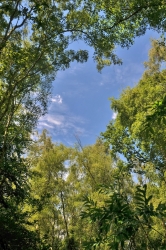 |
| Horsefoot Hill Assembly Point Photo © Ashley Whitlock |
Havant Thicket. Roy Symonds reports to me that he visited Havant Thicket when the temperature was 20 degrees. No Purple Emperors were seen, but half a dozen Silver Washed Fritillarys along with 2 White Admirals and 8 Marbled Whites were seen. Other species found were Brimstone, Large White, Small White, Meadow Brown, Gatekeeper, Ringlet, Small Skipper and Large Skipper. [Posted by Richard Symonds]
Alice Holt. Had a short visit during pretty inclement weather and between the showers managed to spot four maybe five different Purple Emperors. Numbers of Silver Washed Fritillary seem quite low this year but reasonable numbers of White Admirals. Also spotted a few Purple Hairstreaks along with hundreds Ringlets and Meadow Browns. No Female Emperors yet. [Posted by Mark Tutton]
New taxonomic listing. For those that are unaware, I thought it would be worth pointing out that December 2013 saw the release of the "Checklist of the Lepidoptera of the British Isles" by David Agassiz, Stella Beavan and Robert Heckford. This is the first major taxonomy update since Bradley and Bradley in 2000. A summary of changes in relation to butterflies can be found on the UK Butterflies website. One point to note is that the Chalkhill Blue is now the Chalk Hill Blue. I'm mentioning this (as webmaster) since all valid butterfly (and some moth) names are automatically linked from this news page to relevant species pages on the branch website. [Posted by Peter Eeles]
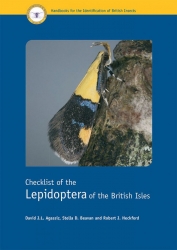 |
| Photo © Peter Eeles |
Graylings at Browndown. Recorded my first sightings of Graylings this year (4) on transect this a.m. at Browndown North. All were seen in a favourite Grayling area, section 10 of the transect They were " put up" by me walking through heather and bristle bent and typically immediately sought refuge in shady corners due the dull weather. This compares with my last years earliest sighting at Browndon on July 15th, week no 16. They possibly emerged in the sunnier weather last weekend.
Also seen for the 1st time this year on this site were a few Gatekeepers. [Posted by Chris Cobb]
Your garden in July. Need new nectar plants to fill spaces in your garden now? My best tip - visit a garden centre or nursery on a sunny day and watch which plants butterflies are visiting. On one occasion a Meadow Brown chose a pale lemon Achillea for me and on another a host of Small Tortoiseshells led me to Elecampane Inula helenium.
Need a new Buddleia? The Longstock Park Nursery near Stockbridge is the place to visit. They have a planting display of dozens of varieties. Check out the lavender at Longstock too. Another great place both to see extensive lavender plantings and with a good range of plants on sale is Long Barn at Alresford.
For long lived herbaceous perennials that are super attractive to moths and butterflies chose Phlox paniculata.. Another long lived plant, an attractive climber, which usually proves alluring to Silver-y moths and Brimstone butterflies is everlasting Sweet pea Lathyrus latfolius.
The one plant I would not be without in July is wild marjoram Origanum vulgare. It enhances any sunny flower bed and attracts butterflies galore. [Posted by Lynn Fomison]
Chalton Down, Old Idsworth. Today Roy Symonds reports he visited Chalton Down (SU736156)where the temperature was 18 degrees. No sign of the Chalkhill Blue at the site yet, but 33 Marbled Whites were recorded as well as a fresh male Brimstone. Other species seen were Meadow Brown, Ringlet, Gatekeeper, Small Heath, Comma, Large Skipper and Small Skipper. [Posted by Richard Symonds]
Chalkhill blue. First of the season at Brading Down today. [Posted by Ian Pratt]
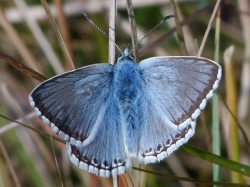 |
| Chalkhill blue Photo © Ian Pratt |
Stockbridge Down delivers!. There are some sites that never, ever, fail to deliver the goods - and Stockbridge Down is such a site. Within the space of a couple of hours this morning I saw more butterflies than I've seen at any point this year - the place is buzzing with activity - with butterflies flying up with almost every footstep in the strip next to the road. I saw a few "firsts" for the year for me, including Chalk Hill Blue (7 males seen), Gatekeeper (4 males seen) and Essex Skipper (2 males seen). The next brood of Small Copper are also starting to emerge, with both a fresh male and fresh female seen.
Stockbridge is special not simply because of the number of butterflies (the Marbled Whites in their hundreds), but because there's always something to see on the Lepidoptera front. As well as finding a Ringlet ab. centrifera, I took a good look at the mites attached to a Fox moth larva, as well as a female Marbled White that played host to the parasitic red mite, Trombidium breei, although such parasitism does not appear to affect the butterfly in any way.
But I was actually visiting to see the Small Skipper, Stockbridge being one of the best sites I know for this relatively-common species; I must have seen at least 50. At one point, I saw a Robber fly snatch a male Small Skipper in mid-air - unbelievable, and nature at its gruesome best! I found 3 mating pairs of Small Skipper and saw 5 females ovipositing in the sheaths of Yorkshire-fog; I'm always amazed how such a small butterfly can get their ovipositor in such a tightly-wrapped grass stem and it's quite amusing watching her "shimmy" down a grass blade and then rotate around the blade in order to find a suitable spot to lay. Full report on the UK Butterflies website. [Posted by Pete Eeles]
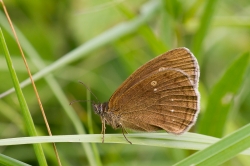 | 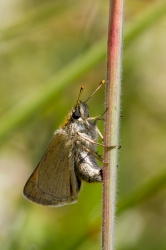 | 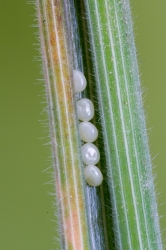 |
| Ringlet (female) ab. centrifera Photo © Pete Eeles | Small Skipper ovipositing Photo © Pete Eeles | Small Skipper ova Photo © Pete Eeles |
Pitt Down. After the mornings events I wandered over to Pitt Down and here the Marbled White was everywhere, impossible to count there must have been many thousands. I specifically went to see the Dark-Green Fritillary though there didn't seem so many as the season of 2013, I counted (25) and there were several lovely females on the wing now.There were good numbers of Small Skippers and a few Silver-Washed Fritillaries as well. The sky was black by 1500 and I beat a hasty retreat, although this weather totally by passed the site. [Posted by Ashley Whitlock]
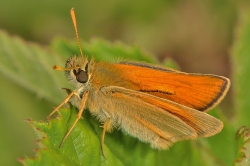 | 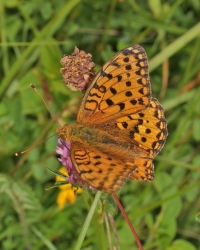 | 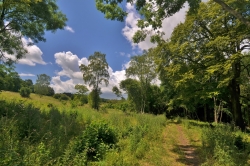 |
| Small Skipper Pitt Down Photo © Ashley Whitlock | Dark-Green Fritillary Pitt Down Photo © Ashley Whitlock | Pitt Down Photo © Ashley Whitlock |
Purple West Wood. I have been in West Wood part of the Crab Wood Farley Mount complex west of Winchester today, despite reservations on showers it turned out to be a good morning in the wood at about 0830, with the sun just creeping into the main ride. There was no Purple Emperor activity early on, and I was shocked to see that the Straits Inclosure syndrome had happened here as well , with good areas of Sallow being cut down in the main ride, and the rides being widened, quite why is anybody's guess. My first encounter with 'HIM' was at 1045, down in the main ride, here he seemed to be quite happy with me taking a few photos, he then decided to fly into the 'new' coppiced area, where he seemed more content, and we were well away from any disturbance, although there was nobody about.He stopped for about 15 minutes, but the sun wasn't strong enough or at the right angle for purple on both wings.The weather was changing and there was black clouds on the horizon, and I thought the Emperor population knew this, as I saw several males at 1105,1106, 1107, 1109,and It wasn't the same one as they were flying in different rides. It then started to rain and I took shelter back at the car, but came back again when the sun came out, and in the main ride I saw at least another (5) males using oak and Ash trees, darting in and out and going over the main ride into Crab Wood. Other memorable species were one Scarlett Tiger Moth, (37) Silver Washed Fritillaries (2) Dark-Green Fritillaries. [Posted by Ashley Whitlock]
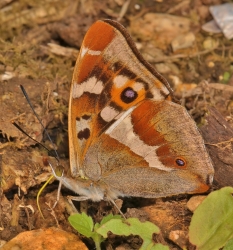 | 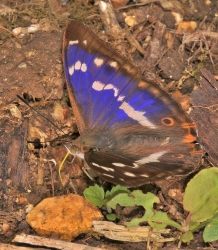 | 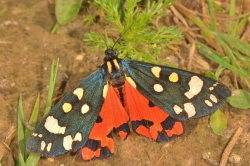 |
| Purple Emperor West Wood Photo © Ashley Whitlock | Purple Emperor in West Wood Photo © Ashley Whitlock | Scarlett Tiger Moth West Wood Photo © Ashley Whitlock |
Chalkhill blue. First one seen at Brading Down Isle of Wight this morning. [Posted by Ian Pratt]
Knowle Village/Aytesbury Copse. I have been studying this area for the last few weeks in the hope of finding something interesting. On Sunday I found my first Essex Skippers of the year. At least three positively identified amongst the more numerous Small Skippers. The Essex skippers all very fresh. Also my first Gatekeepers of the year together with White and Red Admirals, Ringlet, Meadow Brown, Marbled White, Small Tortoiseshell, still a few Large Skippers, one fresh Large White (one of very few seen this year so far) and a couple of Green Veined Whites. I also counted nearly 30 Small Tortoiseshell Larval Webs as well as a few Peacock larvae. [Posted by Paul Harfield]
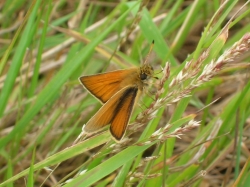 | 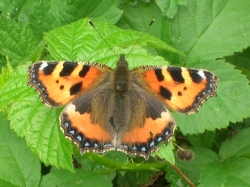 | 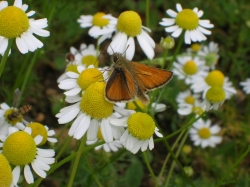 |
| Essex Skipper Photo © Paul Harfield | Small Tortoiseshell Photo © Paul Harfield | Small Skipper on Mayweed Photo © Paul Harfield |
New sightings. First new brood Brimstone seen on buddleja at Longstock Park; one of the few butterflies recorded there. Marbled Whites seen earlier in unprecedented numbers (est. 300), at Nelson (covered) Reservoir on Ports Down, nearly every knapweed flower head seemed to have one. [Posted by Andrew Brookes]
Gatekeepers galore. At least 40 Gatekeepers, including 7rl mating pairs, were on the sea wall and its approaches at Pennington Marsh this morning despite the cool and cloudy conditions and a chilly wind. 5 large skippers and 12 meadow browns also around. [Posted by Alan Butterworth]
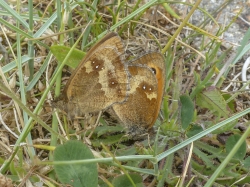 |
| Gatekeeper mating pair Photo © Alan Butterworth |
Chalk Hills at Chalton. They're out! [Posted by Pauline Richards]
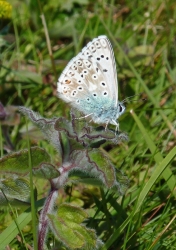 | 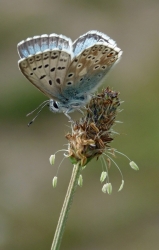 | 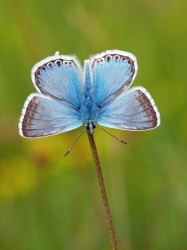 |
| Male Chalk Hill, Chalton Photo © Pauline Richards | Male Chalk Hill, Chalton Photo © Pauline Richards | Male Chalk Hill, Chalton Photo © Pauline Richards |
Grayling at Browndown North. One Grayling at Browndown North [Posted by David Tinling]
Dark green fritillaries. Between 20 and 30 dark green fritillaries at Shalcombe Down IOW this evening before the rain came! [Posted by Ian Pratt]
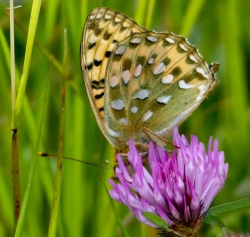 | 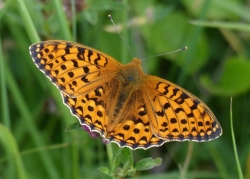 |
| Photo © Ian Pratt | Photo © Ian Pratt |
Portsdown Hill. In hot (22.5 degrees) weather, my father, Roy Symonds walked the eastern end of Portsdown Hill following the path above Queen Alexandra Hospital. He then walked behind Fort Widley and through the grass meadows back to the car park. Here many Marbled Whites were flying around 30 were seen along with Meadow Browns. Other species noted were Ringlet, Gatekeeper, Comma and Small Skipper. [Posted by Richard Symonds]
White Admirals in Gosport. One White Admiral was seen basking under and flying in a holm oak by the shingle beach at Gilkicker(south-west),where I have never seen one before;another was flying in the oak copse at Browndown North,where two were first seen on 18th June. [Posted by David Tinling]
Purple Hairstreaks at Browndown North. 13 Purple Hairstreaks flying in the tops of the oaks in the oak copse at Browndown North at 1900. [Posted by David Tinling]
Grayling at Browndown South. One Grayling seen & photographed at Browndown South on 3rd & 4th July. [Posted by David Tinling]
Grayling - New Forest. Our first Grayling of the year on the wing at Pig Bush this morning. Managed a quick few shots before it flew off. [Posted by Roy Cowley]
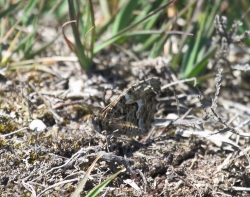 |
| Photo © Roy Cowley |
Grayling On The Wing At Browndown. A late afternoon call at Browndown(S) produced a confirmed sighting of Grayling amongst the heather close to the firing range wall. Usually I manage a photo, but it took off just after I had confirmed the ID and a gust of wind did the rest. A further search of 20 minutes produced no further sightings. [Posted by Alan Thorbury]
Emperor Down In The Straits. A mid-morning visit to the Straits Inclosure (Alice Holt Forest) produced my first close up view of ‘His Majesty’ this season, with a male Purple Emperor down on the gravel track. He was already on the ground taking minerals, when I first spotted him about 100 yards from the entrance. He proceeded to make his way, with short low flights between stops, all the way to the first observation tower, his final flight taking him high into the oaks. Compared to last year, Silver-washed Fritillary and White Admiral numbers seem significantly down, however my day had already been made! [Posted by Alan Thornbury]
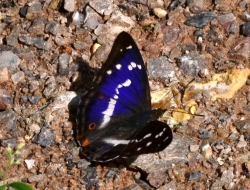 | 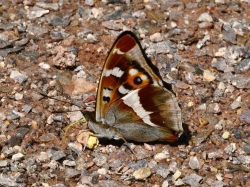 | 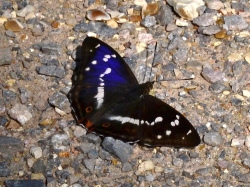 |
| Purple Emperor Photo © Alan Thornbury | Purple Emperor Photo © Alan Thornbury | Purple Emperor Photo © Alan Thornbury |
Purple Havant. Just spent most of the morning in Havant Thicket looking at most of the areas I thought would be good areas for the Purple Emperor, and it would seem to have paid off. I counted upwards of (10) At least (5) in Bells Copse which is a large wood which backs onto the A3 Motorway. I only looked in a small part of the wood, as it goes right through to the Leigh Park Estate. I suspect there are many more Emperors in this wood as there are good areas of Sallow, and there are many Wayleaves to look up at the Oak canopy from the ride. There is plenty of Sallow in Havant Thicket and I saw at least two male Emperors skimming in and out of the many Sallow Hedges which border the site. Several were seen Oak edging, and towards the time of mid-day, I saw at least two males in a Vista at Horsefoot Hill and one in a vista in Bells Copse, on the tallest trees in the wood, I suspect. [Posted by Ashley Whitlock]
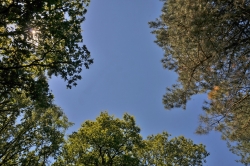 | 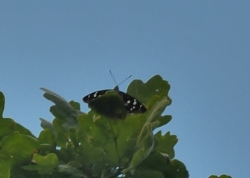 | 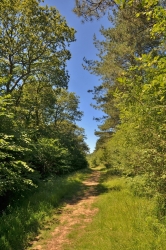 |
| Bells Copse Vista Photo © Ashley Whitlock | Purple Emperor in the Oak Canopy Photo © Ashley Whitlock | Bells Copse Photo © Ashley Whitlock |
Alice Holt Forest. I spent the best part of the day in Alice Holt Forest including Straits Inclosure where the Emperor is getting off to a slow but sure start. I suspect the main bulk of the males should be on the wing now, although the next week will still see some additions with many females coming on line, which should give the Assembly points more interesting chases. I found two males today, one Oak edging along the main ride and another further up the ride near to the entrance,Sallow searching. I only spent about an hour on this site as it takes all day to look at the whole of the Assembly points and main rides. In Abbotts Wood Inclosure, one male was seen at 1030 heading north at the start of the oak line along the main ride, from the small car-park on the south side. Another was seen Sallow searching in the same ride, and later on two males were squabbling in the ride and were chasing each other weaving along the ride and over tops of the Douglas Fir trees, quite why these were doing this I can only surmise is one thought it was a female and found out it wasn't and to save face, gave chase. At the Assembly Point in Abbotts Wood (2) males were seen chasing and settling on Fir trees. I also saw another two chasing very high up in the sky I think these may well have been from ALHF1 which is only a short distant away, some chase! Another (2) were seen in ALHF1 but at the other Assembly points there didn't seem to be any, excepting Goose Green where I arrived at 1305 I think they get up to this site quite late, but at least two were on station, I think many observers probably miss them. There was also one in Georges Glade, where I haven't seen one for quite some time. [Posted by Ashley Whitlock]
Noar Hill. After visiting Alice Holt Forest, Roy Symonds spent a few hours at nearby Noar Hill. Many Marbled White, Ringlet and Meadow Brown were flying along with Speckled Wood, Small Heath, Comma, Red Admiral, Small Tortoiseshell and Large Skipper. The Marbled Whites rarely settled for long before resuming their flight. [Posted by Richard Symonds]
Alice Holt Forest. Roy Symonds visited Straits Inclosure, Alice Holt Forest today where the temperature was 19.5 degrees. He reports seeing two Purple Emperors, one flying in the dip in the main track where the Forestry Commission generator is located on the left hand side, the other flew overhead on the track between the first and second deer towers. Also noted were 24 Silver Washed Fritillarys and 10 White Admirals. Other species seen were Small White, Meadow Brown, Ringlet, Small Tortoiseshell, Comma, Red Admiral, Small Skipper and Large Skipper.
Later around midday a visit was made to Goose Green Inclosure where only Silver Washed Fritillary, Meadow Brown and Ringlet were noted. No sign of any Purple Emperors, although it may have been too early in the afternoon for them to be seen at this location. [Posted by Richard Symonds]
Martin Down Buzzing!. During a visit to Martin Down (Kitts Grave wooded area only) between 0930-1300 I totally lost count of the amount of Marbled Whites, there seemed to be at least one or two on every thistle head! An estimate of 300-400 would not be an exaggeration. Ringlets and Meadow Browns were also seen in similar numbers. Also 12 Dark Green Fritillaries, 8 Silver Washed Fritillaries, 6 White Admirals, 50-80 Small Skippers, 36 Large Skippers, 2 Brimstones, 2 Large Whites, 28 Small Tortoiseshells, 2 Red Admirals, 1 Speckled Wood and 1 Hummingbird Hawkmoth. Of note is the lovely green (almost malachite?) colouration to the back of the Dark Green Fritillary wings, which I have never seen quite so vivid. [Posted by Mark Pike]
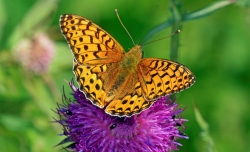 | 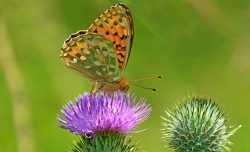 | 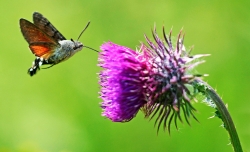 |
| Dark Green Fritillary Photo © Mark Pike | Dark Green Fritillary Photo © Mark Pike | Hummingbird Hawkmoth Photo © Mark Pike |
Havant Thicket SU715105. I had a cycle ride to various locations in Havant Thicket via Bell's Copse today from 0930-1345 which turned out to be a good purple day.I had at least 6 Purple Emperors one of the males which I encountered flew around me a couple of times probably attracted to my blue and white tea shirt and then landed on the footpath only feet from where I was standing,a magical moment.Other butterflies seen included Silver-washed Fritillary 15, White Admiral 2, Brimstone 5, Red Admiral 1, Speckled Wood 2, Gatekeeper 2 and numerous numbers of the following species Meadow Brown, Large and Small Skippers, Ringlets, Marbled Whites and Small White. [Posted by Barry Collins]
Chalton Down, Old Idsworth. Roy Symonds, my father spent two hours walking Chalton Down today where the temperature was 20 degrees. A single Dark Green Fritilllary put in an appearance and briefly landed but alas not long enough to photograph. A total of 26 Marbled White were seen along with my father's first Small Skipper and Gatekeeper sightings this year. Many other species were flying, including Meadow Brown, Ringlet, Speckled Wood, Small Heath, Brimstone, Small White, Small Tortoiseshell, Comma, Common Blue and Large Skipper. [Posted by Richard Symonds]
Creech Wood and Southleigh Forest. One of the largest woods in the Meon Valley part of the Forest of Bere network, this wood was being bashed by a very strong breeze today, and where I stood in the way-leaves, which is quite exposed, the trees didn't offer much protection. Hence I never saw any Purple Emperors I suspect they may have only just started here, and with the good weather projected I suspect I shall see plenty of Emperors in the following weeks. Other butterflies of note were plenty of Silver-Washed Fritillaries, Marbled Whites, and the Gatekeepers, and Small Skippers in the way-leaves... The White Admiral here is very rare; hence I only saw the one. I then went onto Southleigh Forest just north of Emsworth on the Hants/Sussex Border, here I saw two Purple Emperors around an Assembly Point, they were giving chase and giving each other a right old bashing. At first I only saw the one Emperor doing his typical patrol around the Oak canopy, but I did see another one doing the same thing at the other end of the canopy, and it was inevitable they would meet up eventually. [Posted by Ashley Whitlock]
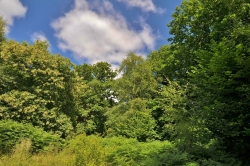 |
| Southleigh Forest Highpoint Photo © Ashley Whitlock |